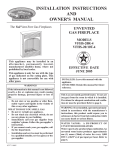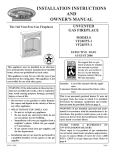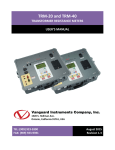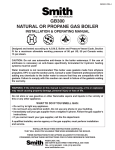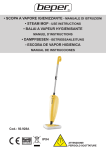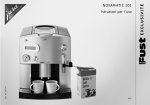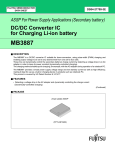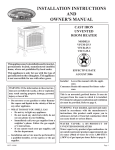Download Empire Comfort Systems ONR-30-1 Owner`s manual
Transcript
INSTALLATION INSTRUCTIONS AND OWNER'S MANUAL The Taos Vent-Free Gas Fireplace UNVENTED ROOM HEATER MODELS VFBL-30-1 VFBH-30-1 This appliance may be installed in an aftermarket, permanently located, manufactured (mobile) home, where not prohibited by local codes. This appliance is only for use with the type of gas indicated on the rating plate. This appliance is not convertible for use with other gases. WARNING: If the information in these instructions are not followed exactly, a fire or explosion may result causing property damage, personal injury or loss of life. — Do not store or use gasoline or other flammable vapors and liquids in the vicinity of this or any other appliance. — WHAT TO DO IF YOU SMELL GAS • Do not try to light any appliance. • Do not touch any electrical switch; do not use any phone in your building. • Immediately call your gas supplier from a neighbor’s phone. Follow the gas supplier’s instructions. • If you cannot reach your gas supplier, call the fire department. — Installation and service must be performed by a qualified installer, service agency or the gas supplier. Installer: Leave this manual with the appliance. Consumer: Retain this manual for future reference. This is an unvented gas-fired heater. It uses air (oxygen) from the room in which it is installed. Provisions for adequate combustion and ventilation air must be provided. Refer to page 6. WARNING: If not installed, operated and maintained in accordance with the manufacturer's instructions, this product could expose you to substances in fuel or from fuel combustion which can cause death or serious illness. WATER VAPOR: A BY-PRODUCT OF UNVENTED ROOM HEATERS Water vapor is a by-product of gas combustion. An unvented room heater produces approximately one (1) ounce (30ml) of water for every 1,000 BTU's (.3KW's) of gas input per hour. Refer to page 6. Page 1 TABLE OF CONTENTS SECTION PAGE Important Safety Information ......................................................................................................................3 Safety Information for Users of LP Gas ......................................................................................................4 Introduction ..................................................................................................................................................5 Specifications ...............................................................................................................................................5 Water Vapor: A By-Product of Unvented Room Heaters .............................................................................6 Provisions for Adequate Combustion and Ventilation Air ...........................................................................6 Gas Supply ...................................................................................................................................................7 Clearances ...................................................................................................................................................8 Combustible Material...................................................................................................................................8 Wall Mount Installation ...............................................................................................................................9 Optional Floor Stand Installation ...............................................................................................................10 Log Placement ...........................................................................................................................................10 Lighting Instructions .................................................................................................................................11 Main Burner Flame Characteristics ..........................................................................................................12 Pilot Flame Characteristics .......................................................................................................................12 Thermostat Operation ................................................................................................................................13 Appliance Maintenance .............................................................................................................................13 Troubleshooting .........................................................................................................................................13 Parts List ....................................................................................................................................................14 How to Order Repair Parts .........................................................................................................................14 Parts View .................................................................................................................................................15 Optional Blower Installation Instructions ........................................................................................... 16-17 Optional Mantel Installation Instructions ..................................................................................................18 Service Notes .............................................................................................................................................19 Page 2 16940-3-1107 IMPORTANT SAFETY INFORMATION THIS IS A HEATING APPLIANCE DO NOT OPERATE THIS APPLIANCE WITHOUT FRONT PANEL INSTALLED. • An unvented room heater having an input rating of more than 6,000 Btu per hour shall not be installed in a bathroom. • An unvented room heater having an input rating of more than 10,000 Btu per hour shall not be installed in a bedroom or bathroom. • Due to high temperatures, the appliance should be located out of traffic and away from furniture and draperies. • Children and adults should be alerted to the hazard of high surface temperature and should stay away to avoid burns or clothing ignition. • Young children should be carefully supervised when they are in the same room with the appliance. • Do not place clothing or other flammable material on or near the appliance. • DO NOT use this room heater if any part has been under water. Immediately call a qualified service technician to inspect the room heater and to replace any part of the control system and any gas control which has been under water. before use and at least annually by a professional service person. More frequent cleaning may be required due to excessive lint from carpeting, bedding materials, etc. It is imperative that control compartments, burners and circulating air passageways of the appliance be kept clean. • Due to high surface temperatures, keep children, clothing and furniture away. • Keep appliance area clear and free from combustible materials, gasoline and other flammable vapors and liquids. • WARNING: ANY CHANGE TO THIS HEATER OR ITS CONTROLS CAN BE DANGEROUS. Any safety screen or guard removed for servicing an appliance must be replaced prior to operating the heater. • WARNING: Failure to keep the primary air opening(s) of the burner(s) clean may result in sooting and property damage. • WARNING: Do not use a blower insert, heat exchanger insert or other accessory not approved for use with heater. • Installation and repair should be done by a QUALIFIED SERVICE PERSON. The appliance should be inspected WARNING When used without adequate combustion and ventilation air, heater may give off CARBON MONOXIDE, an odorless, poisonous gas. Do not install heater until all necessary provisions are made for combustion and ventilation air. Consult the written instructions provided with the heater for information concerning combustion and ventilation air. In the absence of instructions, refer to the National Fuel Gas Code, ANSI Z223.1/NFPA 54, Air for Combustion and Ventilation or applicable local codes. This heater is equipped with a PILOT LIGHT SAFETY SYSTEM designed to turn off the heater if not enough fresh air is available. DO NOT TAMPER WITH PILOT LIGHT SAFETY SYSTEM! If heater shuts off, do not relight until you provide fresh air. If heater keeps shutting off, have it serviced. Keep burner and control compartment clean. 16940-3-1107 CARBON MONOXIDE POISONING MAY LEAD TO DEATH. Early signs of carbon monoxide poisoning resemble the flu, with headache, dizziness and/or nausea. If you have these signs, heater may not be working properly. Get fresh air at once! Have heater serviced. Some people — pregnant women, persons with heart or lung disease, anemia, those under the influence of alcohol , those at high altitudes — are more affected by carbon monoxide than others. The pilot light safety system senses the depletion of oxygen at its location. If this heater is installed in a structure having a high vertical dimension, the possibility exists that the oxygen supply at the higher levels will be less than that at the heater. In this type of application, a fan to circulate the structure air will minimize this effect. The use of this fan will also improve the comfort level in the structure. When a fan is used to circulate air, it should be located so that the air flow is not directed at the burner. Page 3 SAFETY INFORMATION FOR USERS OF LP-GAS Propane (LP-Gas) is a flammable gas which can cause fires and explosions. In its natural state, propane is odorless and colorless. You may not know all the following safety precautions which can protect both you and your family from an accident. Read them carefully now, then review them point by point with the members of your household. Someday when there may not be a minute to lose, everyone's safety will depend on knowing exactly what to do. If, after reading the following information, you feel you still need more information, please contact your gas supplier. LP-GAS WARNING ODOR If a gas leak happens, you should be able to smell the gas because of the odorant put in the LP-Gas. That's your signal to go into immediate action! • • • • Do not operate electric switches, light matches, use your phone. Do not do anything that could ignite the gas. Get everyone out of the building, vehicle, trailer, or area. Do that IMMEDIATELY. Close all gas tank or cylinder supply valves. LP-Gas is heavier than air and may settle in low areas such as basements. When you have reason to suspect a gas leak, keep out of basements and other low areas. Stay out until firefighters declare them to be safe. • • Use your neighbor's phone and call a trained LP-Gas service person and the fire department. Even though you may not continue to smell gas, do not turn on the gas again. Do not re-enter the building, vehicle, trailer, or area. Finally, let the service man and firefighters check for escaped gas. Have them air out the area before you return. Properly trained LP-Gas service people should repair the leak, then check and relight the gas appliance for you. NO ODOR DETECTED - ODOR FADE Some people cannot smell well. Some people cannot smell the odor of the chemical put into the gas. You must find out if you can smell the odorant in propane. Smoking can decrease your ability to smell. Being around an odor for a time can affect your sensitivity or ability to detect that odor. Sometimes other odors in the area mask the gas odor. People may not smell the gas odor or their minds are on something else. Thinking about smelling a gas odor can make it easier to smell. The odorant in LP-gas is colorless, and it can fade under some circumstances. For example, if there is an underground leak, the movement of the gas through soil can filter the odorant. Odorants in LP-Gas also are subject to oxidation. This fading can occur if there is rust inside the storage tank or in iron gas pipes. The odorant in escaped gas can adsorb or absorb onto or into walls, masonry and other materials and fabrics in a room. That will take some of the odorant out of the gas, reducing its odor intensity. LP-Gas may stratify in a closed area, and the odor intensity could vary at different levels. Since it is heavier than air, there may be more odor at lower levels. Always be sensitive to the slightest gas odor. If you detect any odor, treat it as a serious leak. Immediately go into action as instructed earlier. SOME POINTS TO REMEMBER • Learn to recognize the odor of LP-gas. Your local LP-Gas Dealer can give you a "Scratch and Sniff" pamphlet. Use it to find out what the propane odor smells like. If you suspect that your LP-Gas has a weak or abnormal odor, call your LP-Gas Dealer. • If you are not qualified, do not light pilot lights, perform service, or make adjustments to appliances on the LP-Gas system. If you are qualified, consciously think about the odor of LP-Gas prior to and while lighting pilot lights or performing service or making adjustments. • Sometimes a basement or a closed-up house has a musty smell that can cover up the LP-Gas odor. Do not try to light pilot lights, perform service, or make adjustments in an area where the conditions are such that you may not detect the odor if there has been a leak of LP-Gas. • Odor fade, due to oxidation by rust or adsorption on walls of new cylinders and tanks, is possible. Therefore, people should be particularly alert and careful when new tanks or cylinders are placed in service. Odor fade can occur in new tanks, or reinstalled old tanks, if they are filled and allowed Page 4 to set too long before refilling. Cylinders and tanks which have been out of service for a time may develop internal rust which will cause odor fade. If such conditions are suspected to exist, a periodic sniff test of the gas is advisable. If you have any question about the gas odor, call your LP-gas dealer. A periodic sniff test of the LP-gas is a good safety measure under any condition. • If, at any time, you do not smell the LP-Gas odorant and you think you should, assume you have a leak. Then take the same immediate action recommended above for the occasion when you do detect the odorized LP-Gas. • If you experience a complete "gas out," (the container is under no vapor pressure), turn the tank valve off immediately. If the container valve is left on, the container may draw in some air through openings such as pilot light orifices. If this occurs, some new internal rusting could occur. If the valve is left open, then treat the container as a new tank. Always be sure your container is under vapor pressure by turning it off at the container before it goes completely empty or having it refilled before it is completely empty. 16940-3-1107 INTRODUCTION Instructions to Installer 1. Installer must leave instruction manual with owner after installation. 2. Installer must have owner fill out and mail warranty card supplied with unvented room heater. 3. Installer should show owner how to start and operate unvented room heater. Always consult your local Building Department regarding regulations, codes or ordinances which apply to the installation of an unvented room heater. This appliance may be installed in an aftermarket* permanently located, manufactured (mobile) home, where not prohibited by state or local codes. *Aftermarket: Completion of sale, not for purpose of resale, from the manufacturer. This appliance is only for use with the type of gas indicated on the rating plate. This appliance is not convertible for use with other gases. General Information The AVFBL-30 and AVFBH-30 are design certified in accordance with American National Standard Z21.11.2 by the Canadian Standards Association as an Unvented Room Heater and shall be installed according to these instructions. Attention: During initial use of ceramic log you will detect an odor as the ceramic log is cured. Also, during the curing process the ceramic log will burn with a yellow flame. Any alteration of the original design, installed other than as shown in these instructions or use with a type of gas not shown on the rating plate is the responsibility of the person and company making the change. WARNING: This appliance is equipped for (natural gas or propane) gas. Field conversion is not permitted. Important All correspondence should refer to complete Model Number, Serial Number and type of gas. Notice: During initial firing of this unit, its paint will bake out, and smoke will occur. To prevent triggering of smoke alarms, ventilate the room in which the unit is installed. Qualified Installing Agency Installation and replacement of gas piping, gas utilization equipment or accessories and repair and servicing of equipment shall be performed only by a qualified agency. The term "qualified agency" means any individual, firm, corporation or company which either in person or through a representative is engaged in and is responsible for (a) the installation or replacement of gas piping or (b) the connection, installation, repair or servicing of equipment, who is experienced in such work, familiar with all precautions required and has complied with all the requirements of the authority having jurisdiction. State of Massachuetts: The installation must be made by a licensed plumber or gas filter in the Commonwealth of Massachusetts. Sellers of unvented propane or natural gas-fired supplemental room heaters shall provide to each purchaser a copy of 527 CMR 30 upon sale of the unit. The installation must conform with local codes or, in the absence of local codes, with the National Fuel Gas Code, ANSI Z223.1/ NFPA54.* *Available from the American National Standards Institute, Inc., 11 West 42nd St., New York, N.Y. 10036. Well Head Gas Installations Some natural gas utilities use "well head" gas. This may affect the Btu output of the unit. Contact the gas company for the heating value. Contact the manufacturer or your gas company before changing spud/orifice size. High Altitudes For altitudes/elevations above 2,000 feet (610m), ratings should be reduced at the rate of 4 percent for each 1,000 feet (305m) above sea level. Contact the manufacturer or your gas company before changing spud/orifice size. SPECIFICATIONS Model Input BTU/HR (KW/H) Max. BTU/HR (KW/H) Min. Height Width Depth Gas Inlet 16940-3-1107 AVFBL-30/AVFBH-30 30,000 (8.8) 14,000 (4.1) 22" 26" 7 5/8" 3/8" (10mm) Accessories Automatic Blower Polished Brass Frame Floor Stand VFB-BK VFF1A-20BR VFBFS Page 5 WATER VAPORT: A BY-PRODUCT OF UNVENTED ROOM HEATERS Water vapor is a by-product of gas combustion. An unvented room heater produces approximately one (1) ounce (30ml) of water for every 1,000 BTU's (.3KW's) of gas input per hour. Unvented room heaters are recommended as supplemental heat (a room) rather than a primary heat source (an entire house). In most supplemental heat applications, the water vapor does not create a problem. In most applications, the water vapor enhances the low humidity atmosphere experienced during cold weather. The following steps will help insure that water vapor does not become a problem. 1. Be sure the heater is sized properly for the application, including ample combustion air and circulation air. 2. If high humidity is experienced, a dehumidifier may be used to help lower the water vapor content of the air. 3. Do not use an unvented room heater as the primary heat source. PROVISIONS FOR ADEQUATE COMBUSTION & VENTILATION AIR This heater shall not be installed in a confined space or unusually tight construction unless provisions are provided for adequate combustion and ventilation air. The National Fuel Gas Code, ANSI Z223.1 defines a confined space as a space whose volume is less than 50 cubic feet per 1,000 Btu per hour (4.8m3 per kw) of the aggregate input rating of all appliances installed in that space and an unconfined space as a space whose volume is not less than 50 cubic feet per 1,000 Btu per hour (4.8m3 per kw) of the aggregate input rating of all appliances installed in that space. Rooms communicating directly with the space in which the appliances are installed, through openings not furnished with doors, are considered a part of the unconfined space. The following example is for determining the volume of a typical area in which the AVFBL-30 or AVFBH-30 may be located and for determining if this area fits the definition of an unconfined space. The maximum input of the AVFBL-30 or AVFBH-30 is 30,000 Btu per hour. Based on the 50 cubic feet per 1,000 Btu per hour formula, the minimum area that is an unconfined space for installation of the AVFBL-30 or AVFBH-30 is 1,500 cubic feet, 50 cubic feet x 30 = 1,500 cubic feet. To determine the cubic feet of the area in which the AVFBL-30 or AVFBH-30 is to be installed, measure the length, width and height of the area. Example: The area measures 20 feet in length, 10 feet in width and 8 feet in height, the area is 1,600 cubic feet. The AVFBL-30 or AVFBH-30 can be installed in this unconfined space with no requirement to provide additional combustion and ventilation air. Page 6 Warning: If the area in which the heater may be operated is smaller than that defined as an unconfined space or if the building is of unusually tight construction, provide adequate combustion and ventilation air by one of the methods described in the National Fuel Gas Code, ANSI Z223.1/NFPA 54, Air for Combustion and Ventilation, or applicable local codes. Unusually Tight Construction The air that leaks around doors and windows may provide enough fresh air for combustion and ventilation. However, in buildings of unusually tight construction, you must provide additional fresh air. Unusually tight construction is defined as construction where: a. Walls and ceilings exposed to the outside atmosphere have a continuous water vapor retarder with a rating of one perm or less with openings gasketed or sealed, and b. Weatherstripping has been added on openable windows and doors, and c. Caulking or sealants are applied to areas such as joints around window and door frames, between sole plates and floors, between wall-ceiling joints, between wall panels, at penetrations for plumbing, electrical, and gas lines, and at other openings. If the AVFBL-30 or AVFBH-30 heater is installed in a building of unusually tight construction, adequate air for combustion, ventilation and dilution of flue gases shall be provided in accordance with ANSI Z223.1/NFPA54. 16940-3-1107 GAS SUPPLY The gas line can be routed either through the floor or wall. The gas line opening should be made at this time. Location of the opening will be determined by the position of floor joists and the valve and union used for servicing. Check all local codes for requirements, especially for the size and type of gas supply line required. Recommended Gas Pipe Diameter Pipe Length Schedule 40 Pipe Tubing, Type L Inside Diameter Outside Diameter Nat. L.P. Nat. L.P. 0-10 feet 1/2” 3/8” 1/2” 3/8” 0-3 meters 12.7mm 9.5mm 12.7mm 9.5mm 10-40 feet 1/2” 1/2” 5/8” 1/2” 4-12 meters 12.7mm 12.7mm 15.9mm 12.7mm 40-100 feet 1/2” 1/2” 3/4” 1/2” 13-30 meters 12.7mm 12.7mm 19mm 12.7mm 100-150 feet 3/4” 1/2” 7/8” 3/4” 31-46 meters 19mm 12.7mm 22.2mm 19mm Note: Never use plastic pipe. Check to confirm whether your local codes allow copper tubing or galvanized. Note: Since some municipalities have additional local codes, it is always best to consult your local authority and installation code. A gas valve and ground joint union should be installed in the gas line upstream of the gas control to aid in servicing. It is required by the National Fuel Gas Code that a drip line be installed near the gas inlet. This should consist of a vertical length of pipe tee connected into the gas line that is capped on the bottom in which condensation and foreign particles may collect. Figure 2 Method of Installing a Tee Fitting Sediment Trap (Figure 2) The use of the following gas connectors is recommended: — ANS Z21.24 Appliance Connectors of Corrugated Metal Tubing and Fittings — ANS Z21.45 Assembled Flexible Appliance Connectors of Other Than All-Metal Construction The above connectors may be used if acceptable by the authority having jurisdiction. Figure 1 Installing a New Main Gas Cock Each appliance should have its own manual gas cock. A manual main gas cock should be located in the vicinity of the unit. Where none exists, or where its size or location is not adequate, contact your local authorized installer for installation or relocation. Compounds used on threaded joints of gas piping shall be resistant to the action of liquefied petroleum gases. The gas lines must be checked for leaks by the installer. This should be done with a soap solution watching for bubbles on all exposed connections, and if unexposed, a pressure test should be made. Never use an exposed flame to check for leaks. Appliance must be disconnected from piping at inlet of control valve and pipe capped or plugged for pressure test. Never pressure test with appliance connected; control valve will sustain damage! 16940-3-1107 Pressure Testing of the Gas Supply System 1. To check the inlet pressure to the gas valve, a 1/8" (3mm) N.P.T. plugged tapping, accessible for test gauge connection, must be placed immediately upstream of the gas supply connection to the appliance. 2. The appliance and its individual shutoff valve must be disconnected from the gas supply piping system during any pressure testing of that system at test pressures in excess of 1/2 psig (3.5 kPa). 3. The appliance must be isolated from the gas supply piping system by closing its individual manual shutoff valve during any pressure testing of the gas supply piping system at test pressures equal to or less than 1/2 psig (3.5 kPa). ATTENTION! If one of the above preocedures results in pressures in excess of 1/2 psig (14" w.c.) (3.5kPa) on the appliance gas valve, it will result in a hazardous condition. Checking Manifold Pressure Natural gas will have a manifold pressure of approximately 3.5" (.871kPa) w.c. at the pressure reggulator outlet with the inlet pressure to the pressure regulator from a minimum of 4.5" w.c. (1.120kPa) for the purpose of input adjsutments to a maximum of 10.5" w.c. (2.614kPa) Propane gas will have a manifold pressure approximately 10.0" w.c. (2.49kPa) at the pressure regulator from a minimum of 11.0" w.c. (3.237kPa). A test gage conection is located downstream of the gas appliance pressure regulator for measuring gas pressure. The connection is a 1/8 inch 3mm) N.P.T. plugged tapping. Page 7 CLEARANCES When facing the front of the appliance the following minimum clearances to combustible construction must be maintained. Left side 6 inches (152mm). Right side 6 inches (152mm). Do not install in alcove or closet. Rear wall 0 inches (0mm). Ceiling 36 inches (914mm). Floor (top surface of carpeting, tile, etc.) 2 inches (51mm). Provide adequate clearances around air openings. Adequate accessibility clearances for purposes of servicing and proper operation must be provided. Figure 3 Figure 4 COMBUSTIBLE MATERIAL Do not attach combustible material to the mantel of your fireplace. This is a fire hazard. Figure 5 Page 8 No greeting card, stocking or ornamentation of any type should be placed on or attached to the fireplace. This is a heating appliance. The flow of heat can ignite combustibles. Figure 6 16940-3-1107 WALL MOUNT INSTALLATION Refer to Figure 8 for measurements to attach wall bracket and heater onto wall. Figure 8 is the front view of heater. Refer to Figure 8 for measurements to attach wall bracket and heater onto wall. Figure 8 is the front view of heater. Attachment of Heater Onto Wall Using 10 x 1-1/2" Screws Attention: Use 10 x 1-1/2" screws to mount heater onto wall whenever you can use 16" on-center wall studs for attachment of heater onto wall. Attachment of Heater Onto Wall Using Plastic Expansion Anchors Attention: Use must use plastic expansion anchors to mount heater onto wall whenever you cannot use 16" on-center wall studs for attachment of heater onto wall. 1. Refer to Figure 7 for attachment of (2) standoffs to heater back with (2) 8 x 3/4" screws. 2. Remove casing front from heater. 3. Locate (2) 16" on-center wall studs. Attach wall bracket to 16" on-center wall studs with (2) 10 x 1-1/2" screws. 4. Align slots on heater with wall bracket and pivot heater onto wall bracket. 5. Align clearance hole on interior, left of heater with screw hole on wall bracket. Attach heater to wall bracket with (1) 10 x 1/2" screw. 6. Installation of heater onto wall is completed. 1. Refer to Figure 7 for attachment of (2) standoffs to heater back with (2) 8 x 3/4" screws. 2. Remove casing front from heater. 3. Position wall bracket in correct location on wall. Use clearance holes on wall brackets to mark (2) mounting holes on wall. 4. After locating mounting holes, drill (2) 5/16" diameter holes into wall. 5. Insert (2) plastic expansion anchors into (2) 5/16" holes. 6. Attach wall bracket to plastic expansion anchors with (2) 10 x 1" screws. Refer to Figure 9. 7. Align slots on heater with wall bracket and pivot heater onto wall bracket. 8. Align clearance hole on interior, left of heater with screw hole on wall bracket. Attach heater to wall bracket with (1) 10 x 1/2" screw. 9. Installation of heater onto wall is completed. Figure 7 Figure 9 Figure 8 16940-3-1107 Page 9 OPTIONAL FLOOR STAND INSTALLATION Optional VFBFS Floor Stand Installation 1. Remove (4) 10 x 1/2" screws located in bottom of heater. 2. Align clearance holes on floor stand with screw holes on bottom of heater (See Figure 10). 3. Attach floor stand to heater with (4) 10 x 1/2" screws removed in Step 1. 4. Installation of optional floor stand is completed. Installation on Rugs and Tile If this appliance is installed directly on carpeting, tile or other combustible material, other than wood flooring, the appliance shall be installed on a metal or wood panel extending the full width and depth of the appliance. Attention: Optional VFBFS Floor Stand meets requirement. The base referred to above does not mean the fire-proof base as used on wood stoves. The protection is for rugs that are extremely thick and light colored tile. Figure 10 LOG PLACEMENT AVFBH-30/AVFBL-30 Do not, handle log(s) with your bare hands! Always wear gloves to prevent skin irritation from ceramic fibers. After handling log(s), wash your hands gently with soap and water to remove any traces of fibers. 5. Replace casing front assembly with (2) 10 x 1/2" screws from Step 1. 6. Log placement is completed. The positioning of the log(s) is critical to the safe and clean operation of this heater. Sooting and other problems may result if the log(s) are not properly and firmly positioned in the appliance. Refer to Figures 11 and 12 for the following warning. Warning: Failure to position the parts in accordance with this diagram or failure to use only parts specifically approved with this appliance may result in property damage or personal injury. PROPER INSTALLATION SEQUENCE: AVFBH-30 (Figure 11) 1. Remove casing front assembly, two (2) 10 x 1/2" screws. 2. Remove screen assembly, two (2) truss-head Phillips screws. 3. Place rear log into log support brackets. The log support brackets are located behind main burner. 4. Place front log onto front log support. 5. Replace screen assembly with two (2) truss-head Phillips screws from Step 2. 6. Replace casing front assembly with two (2) 10 x 1/2" screws from Step 1. 7. Log placement is completed.. PROPER INSTALLATION SEQUENCE: AVFBL-30 (Figure 12) 1. Remove casing front assembly, two (2) 10 x 1/2" screws. 2. Remove screen assembly, two (2) truss-head Phillips screws. 3. Place rear log into log support brackets. The log support brackets are located behind main burner. 4. Replace screen assembly with two (2) truss-head Phillips screws from Step 2. Page 10 Figure 11 Figure 12 16940-3-1107 LIGHTING INSTRUCTIONS FOR YOUR SAFETY READ BEFORE LIGHTING WARNING: If you do not follow these instructions exactly, a fire or explosion may result causing property damage, personal injury or loss of life. A. This appliance has a pilot which must be lighted by hand. When lighting the pilot, follow these instructions exactly. B. BEFORE LIGHTING smell all around the appliance area for gas. Be sure to smell next to the floor because some gas is heavier than air and will settle on the floor. WHAT TO DO IF YOU SMELL GAS • Do not try to light any appliance. • Do not touch any electrical switch; do not use any phone in your building. • Immediately call your gas supplier from a neighbor's phone. Follow the gas supplier's instructions. • If you cannot reach your gas supplier, call the fire department. C. Use only your hand to push in or turn the gas control knob. Never use tools. If the knob will not push in or turn by hand, don't try to repair it; call a qualified service technician. Force or attempted repair may result in a fire or explosion. D. Do not use this appliance if any part has been under water. Immediately call a qualified service technician to inspect the appliance and to replace any part of the control system and any gas control which has been under water. LIGHTING INSTRUCTIONS 1. STOP! Read the safety information above. 2. Set the thermostat (gas control knob) to lowest setting. 3. Turn off all electric power to the appliance (if applicable). 4. Remove front panel. 5. Push in gas control knob slightly and turn clockwise to "OFF". 6. Wait ten (10) minutes to clear out any gas. Then smell for gas, including near the floor. If you smell gas, STOP! Follow "B" in the safety information above. If you don't smell gas, go to the next step. 7. Find pilot - follow metal tube from gas control. The pilot is • If knob does not pop up when released, stop and immediately call your service technician or gas supplier. • If the pilot will not stay lit after several tries, turn the gas control knob to "OFF" and call your service technician or gas supplier. 10. Attention! Gas control has an INTERLOCK latching device. When the pilot is initially lit and the safety magnet is energized (pilot stays "ON") the INTERLOCK latching device becomes operative. If the gas control is turned to the "OFF" position or gas flow to the appliance is shut off, the pilot cannot be relighted until the safety magnet is de-energized (approximately 60 seconds). There will be an audible "click" when the safety magnet in the gas control is de-energized. Pilot can now be relighted. Repeat steps 5 through 9. 11. Turn gas control knob counterclockwise attached to the main burner to "HI" 12. Replace front panel. which is located at bottom 13. Turn on all electric power to the appliance (if applicable). of combustion chamber. 8. 9. Push in gas control knob all the way and hold in. Repeatedly push the piezo ignitor button until pilot is lit (or use a match to light pilot). Continue to hold the control knob in for about one (1) minute after the pilot is lit. Release knob and it will pop back up. Pilot should remain lit. If it goes out, repeat steps 5 through 9. Turn knob on gas control counterclockwise to "PILOT." 14. Set thermostat (gas control knob) to desired setting from "HI" to "LO". TO TURN OFF GAS TO APPLIANCE 1. 2. Set the thermostat (gas control knob) to lowest setting. Turn off all electric power to appliance if service is to be performed (if applicable). 16940-3-1107 3 Push in gas control knob slightly and turn clockwise to "OFF". Do not force. Page 11 MAIN BURNER FLAME CHARACTERISTICS There will be a short blue inner flame with a much larger lighter blue secondary flame. The burner flame may have a small yellow tip when hot. Dust in the combustion air will produce an orange or red flame. Do not mistake the orange or red flame for an improper yellow flame. On Propane gas, if a whistling noise (resonation) occurs screw the orifice fitting toward the main burner in order to reduce the amount of primary air. The reduction in primary air will soften the main burner flame and will eliminate the whistling noise (resonation). On Propane or Natural gas, if a yellow flame occurs screw the orifice fitting away from the main burner in order to increase the amount of primary air. The increase in primary air will sharpen the main burner flame and will eliminate the yellow flame. After use, cleaning of the main burner may be required for the proper flame. The main burner may be cleaned by forcing water into the ports and the throat of the burner. The burner should be blown dry or heated to remove all water before replacing. To remove main burner, see Appliance Maintenance. Figure 13 PILOT FLAME CHARACTERISTICS Figure 14 shows a correct pilot flame pattern. The correct flame will be blue and will extend beyond the thermocouple. The flame will surround the thermocouple just below the tip. A slight yellow flame may occur where the pilot flame and main burner flame meet. Figure 15 shows an incorrect pilot flame pattern. The incorrect pilot flame is not touching the thermocouple. This will cause the thermocouple to cool. When the thermocouple cools, the heater will shut down. If pilot flame pattern is incorrect, as shown in Figure 15 • See Troubleshooting, page 13. Cleaning and Maintenance/Pilot Oxygen Depletion Sensor Pilot (Figure 16) When the pilot has a large yellow tip flame, clean the Oxygen Depletion Sensor as follows: 1. Remove screen from casing. 2. Remove front log from front log support on AVFBH-30. 3. Remove front log support. 4. Clean the ODS pilot by loosening nut B from the pilot tubing. When this procedure is required, grasp nut A with an open end wrench. 5. Blow air pressure through the holes indicated by the arrows. This will blow out foreign materials such as dust, lint and spider webs. Tighten nut B also by grasping nut A. 6. Replace front log support. 7. Replace front log onto front log support on AVFBH-30. 8. Replace screen onto casing. Correct Flame Pattern Figure 14 Figure 16 Warning: Never use needles, wires, or similar cylindrical objects to clean the pilot to avoid damaging the calibrated ruby that controls the gas flow. Incorrect Flame Pattern Figure 15 Page 12 16940-3-1107 THERMOSTAT OPERATION To ignite main burner, rotate gas control knob counterclockwise toward HI setting. To shut down main burner, rotate gas control knob clockwise toward LO setting. The gas control modulates from a minimum input of 14,000 BTU /HR (4.1KW/H) (LO setting) to a maximum input of 30,000 BTU/ HR (8.8KW/H) (HI setting). The hydraulic thermostat bulb which is located at the casing assembly bottom adjusts the main burner flame between minimum input and maximum input. Note: When the hydraulic thermostat bulb is "satisfied" the main burner flame will shut "OFF" with the pilot flame remaining "ON". 55°F (12.78°C) to 90°F (32.22°C), respectively. This is the temperature at the hydraulic thermostat bulb not the room temperature. The owner is advised to determine the particular heat setting that is desired for comfort, as heating requirements are different for every owner. Attention: If the owner does not want the main burner to ignite and turns the gas control knob to the Lo setting, the main burner will still ignite if the temperature at the hydraulic thermostat bulb drops to 55°F (12.78°C) . If no heat is desired, turn the gas control knob to the PILOT position. The LO and HI setting has temperature range of approximately APPLIANCE MAINTENANCE To Remove Main Burner 1. Disconnect pilot assembly from main burner. 2. Disconnect outlet tubing from orifice fitting. 3. Disconnect orifice fitting from main burner. 4. Remove #8 x 1/4" (6mm) screw from burner mounting bracket. 5. Remove main burner from combustion chamber. 6. Check for gas leaks at all gas connections after main burner has been replaced into combustion chamber. To Adjust Orifice Fitting 1. Disconnect outlet tubing from orifice fitting. 2. Screw orifice fitting toward or away from main burner. 3. Connect outlet tubing onto orifice fitting. 4. Check for gas leaks. To Remove Main Burner Orifice 1. Grasp the orifice fitting with a 5/8" (16mm) open end wrench. 2. Use 3/8" (10mm) open end wrench to remove main burner orifice from orifice fitting, turn counterclockwise. 3. Check for gas leaks after main burner orifice has been replaced into orifice fitting. Piezo Pilot Ignitor Instructions Depressing the ignitor button completely causes a spark to occur at the pilot. To light the pilot, it is important that the electrode be 1/8" (3mm) from the pilot. The spark must occur at the point the pilot flame hits the thermocouple. On a new installation with air in the gas line, it is suggested that TROUBLESHOOTING SYMPTOMS - POSSIBLE CAUSES AND CORRECTIONS 1. Spark electrode does not produce spark. a. Spark electrode broken - replace. b. Ignitor wire may not be attached to spark electrode attach. c. Ignitor wire damaged - replace. d. Piezo ignitor defective - replace. 2. Spark electrode produces spark but pilot does not light. a. No gas to heater - turn on gas. b. PILOT position not properly aligned - turn gas control knob to PILOT position and depress. c. Pilot is blocked from spider web or dirt - clean pilot, see Page 12. 3. Pilot flame does not stay "ON" when control knob is released. a. Control knob in PILOT position not completely depressed or held in long enough. 16940-3-1107 b. INTERLOCK latching device is operative - see "Lighting Instructions," Page 11, Step 10. c. Thermocouple not tightened into gas control - tighten thermocouple. d. Pilot flame not surrounding thermocouple - clean pilot, see Page 12. Inlet gas pressure too low, contact gas supplier. e. Thermocouple defective - replace. f. Gas control defective - replace. 4. Main burner does not ignite. a. Main burner orifice is blocked - clean, see "Appliance Maintenance," above. Inlet gas pressure too low, contact gas supplier. 5. Heater keeps shutting "OFF" during normal operation. a. Pilot is blocked - clean pilot, see Page 12. b. Inlet gas pressure too low, contact gas supplier Page 13 PARTS LIST PLEASE NOTE: When ordering parts, it is very important that part number and description of part coincide. Index No. Part Number Description AVFBH-30 AND AVFBL-30 PARTS LIST Index No. Part Number Description 14 R-6468 FRONT LOG - AVFBH-30 15 11942 REFLECTOR ASSEMBLY - AVFBH-30 (INCLUDES 11) 15 12876 REFLECTOR ASSEMBLY - AVFBL-30 (INCLUDES 11) 16 11843 SCREEN ASSEMBLY 17 11946 CASING FRONT ASSEMBLY - AVFBH-30 ONLY (INCLUDES BRASS LOUVERS) 17 11927 CASING FRONT ASSEMBLY AVFBL-30 ONLY 1 11847 WALL BRACKET 2 R-2313 PIEZO IGNITOR 3 11928 CASING ASSEMBLY 4 SR-113 VALVE BRACKET 5 12274 VALVE ASSEMBLY - NAT ONLY 5 12275 VALVE ASSEMBLY - LP ONLY 6 11844 UPPER SHIELD 7 R-2882 CABLE CLIP 8 11845 BURNER REGULATOR BRACKET (2 REQ’D) NOT SHOWN 11937 TUBING ASSEMBLY - INLET REGUALTOR TO VALVE 9 R-6419 BURNER NOT SHOWN 11938 10 R-6462 ODS PILOT ASSEMBLY - NAT ONLY TUBING ASSEMBLY - VALVE TO BURNER 10 R-6463 ODS PILOT ASSEMBLY - LP ONLY NOT SHOWN 11941 11 11851 FRONT LOG SUPPORT - AVFBL-30 ONLY TUBING ASSEMBLY - VALVE TO PILOT NOT SHOWN R-2390 IGNITOR WIRE 11 11846 FRONT LOG SUPPORT - AVFBH-30 ONLY NOT SHOWN P-214 ORIFICE - LP NOT SHOWN P-270 ORIFICE - NAT 12 R-2784 INLET REGUALTOR - NAT ONLY NOT SHOWN P-212 ORIFICE HOLDER 12 R-2480 INLET REGULATOR - LP ONLY NOT SHOWN R-6573 STANDOFF (2 REQUIRED) 13 R-6467 REAR LOG - AVFBH-30 AND AVFBL-30 NOT SHOWN R-2685 MIN. RATE SCREW LP 1.30 NOT SHOWN R-2684 MIN. RATE SCREW NAT 2.30 USE ONLY MANUFACTURER'S REPLACEMENT PARTS. USE OF ANY OTHER PARTS COULD CAUSE INJURY OR DEATH. HOW TO ORDER REPAIR PARTS Parts can be ordered only through your service person or dealer. For best results, the service person or dealer should order parts through the distributor. Parts can be shipped directly to the service person/dealer. All parts listed in the Parts List have a Part Number. When ordering parts, first obtain the Model Number from the name plate on your equipment. Then determine the Part Number (not the Index Number) and the Description of each part from the following appropriate illustration and list. Be sure to give all this information. Furnace Model Number Part Description Furnace Serial Number Part Number Type of Gas (Propane or Natural) Do not order bolts, screws, washers or nuts. They are standard hardware items and can be purchased at any local hardware store. Shipments contingent upon strikes, fires and all causes beyond our control. Page 14 Empire Comfort Systems, Inc. Nine Eighteen Freeburg Ave. Belleville, Illinois 62222-0529 16940-3-1107 PARTS VIEW 16940-3-1107 Page 15 OPTIONAL BLOWER INSTALLATION INSTRUCTIONS VFB-BK for Unvented Room Heater Model AVFBL-30 or AVFBH-30 INSTALLING OPTIONAL BLOWER VFB-BK. If heater is installed on wall, in order to install optional blower, the heater must be removed from wall. 1. Remove casing front assembly, (2) screws. 2. Align (4) clearance holes on motor mounting bracket with (4) screw holes on casing assembly back and attach motor mounting bracket with (4) #10 x 5/16" (8mm) screws provided. The motor wires should be facing to the left and then routed behind the motor mounting bracket and to the right as depicted in drawing below. 3. Route cord set through 9/16" (14mm) hole on casing assembly back. Insert approximately 3" (76mm) of cord set into casing assembly back. 4. Use #10 x 5/16" (8mm) screw included in hardware package to attach green ground wire from cord set to screw hole which is adjacent to cord set access hole on casing back. 7. Attach (1) pin terminal from black (hot) wire, smooth insulation on cord set to (1) socket terminal on fan control assembly. 8. Attach (1) pin terminal from black (neutral) wire, ribbed insulation on cord set to (1) socket terminal on motor wire. 9. Attach (1) pin terminal on fan control assembly to (1) socket terminal on motor wire. 10. Grasp cord set at casing assembly back and pull excess cord set through casing assembly back and secure cord set in casing assembly back with the strain relief provided. 11. Replace casing front assembly, (2) screws. Attention: Be sure all wires are located away from fan blade. 5. Attach fan control to upper shield with (2) #8 x 3/8" screws. 6. Attach (2) fan control wires to fan control. Page 16 16940-3-1107 OPTIONAL BLOWER INSTALLATION INSTRUCTIONS (continued) Wiring The appliance, when installed, must be electrically grounded in accordance with local codes or, in the absence of local codes, with the National Electrical Code ANSI/NFPA No. 70, if an external electrical source is utilized. This appliance is equipped with a three-prong [grounding] plug for your protection against shock hazard and should be plugged directly into a properly grounded three-prong receptacle. Do not cut or remove the grounding prong from this plug. For an ungrounded receptacle, an adapter, which has two prongs and a wire for grounding, can be purchased, plugged into the ungrounded receptacle and its wire connected to the receptacle mounting screw. With this wire completing the ground, the appliance cord plug can be plugged into the adapter and be electrically grounded. CAUTION: Label all wires prior to disconnection when servicing controls. Wiring errors can cause improper and dangerous operation. Verify proper operation after servicing. Oiling Blower Motor The blower motor does not have oiling holes. Do not attempt to oil the blower motor. If any of the original wire as supplied with the appliance must be replaced, it must be replaced with type 125°C wire or its equivalent. . .. WARNING: Unplugging of blower accessory will not stop the heater from cycling. To turn off gas to the unvented heater: Push in gas control knob slightly and turn clockwise to "OFF." Do not force. PARTS LIST Index No. 1 2 3 4 5 6 7 Part Number Description R-1468 VF-153 R-2695 R-2696 R-2503 R-2395 VF-068 Bushing Mounting Bracket Motor Fan Blade Fan Control Wire Assembly Cord Set 16940-3-1107 Page 17 OPTIONAL MANTEL INSTALLATION INSTRUCTIONS 1. Place base adjacent to gas inlet supply. 2. Remove thermostat bulb from plastic bracket located on exterior, bottom of heater. Loosen screw for plastic bracket, turn plastic bracket 180° (to the outside of heater), tighten screw for plastic bracket and replace thermostat bulb into plastic bracket. 3. Place heater onto base. 4. Attach gas inlet supply to heater. Check for gas leaks on all gas connections. 7. Align channels on brass frame sides with crimp angles and insert two (2) brass frame sides into the two (2) sets of crimp angles. Tighten set screws in crimp angles in order to assemble brass frame. 8. Place brass frame around front of heater. Align six (6) clearance holes on frame with six (6) screw holes on heater. 9. Align clearance holes on two (2) mounting brackets with bottom clearance holes on brass frame sides. Figure 2. 5. Lay brass frame assembly face down on a non-abrasive surface. 10. Use four (4) truss-head Phillips screws to attach mounting brackets and brass frame sides to heater. 6. Insert one (1) flat crimp angle and one (1) crimp angle with set screws into channel on brass frame top. Repeat process on opposite end of brass frame top with two (2) additional crimp angles. Figure 1. 12. Use two (2) truss-head Phillips screws to attach mounting brackets and brass frame top to heater. 11. Align clearance holes on two (2) mounting brackets with clearance holes on brass frame top. 13. Align notches on mantel sides with notches on base. Insert mantel sides into mantel base and behind brass frame sides. 14. Insert breastboard behind brass frame top and in front of mounting brackets on brass frame top. The breastboard top will be flush with the mantel sides. 15. Use four (4) 1-1/4"wood screws to attach breastboard to mantel sides. 16. Align two (2) nail flange brackets with pilot holes in mantel sides. Figure 3. 17. Use four (4) 1/2" wood screws to attach nail flange brackets to mantel sides. 18. Use two (2) 10 x 1" screws to attach nail flange brackets to wall. 19. Place mantel top onto breastboard and mantel sides. 20. Installation of optional mantel is completed. Page 18 16940-3-1107 SERVICE NOTES 16940-3-1107 Page 19 Empire Comfort Systems, Inc. 918 Freeburg Ave. Belleville, IL 62220 PH: 618-233-7420 or 800-851-3153 FAX: 618-233-7097 or 800-443-8648 [email protected] www.empirecomfort.com Page 20 16940-3-1107




















